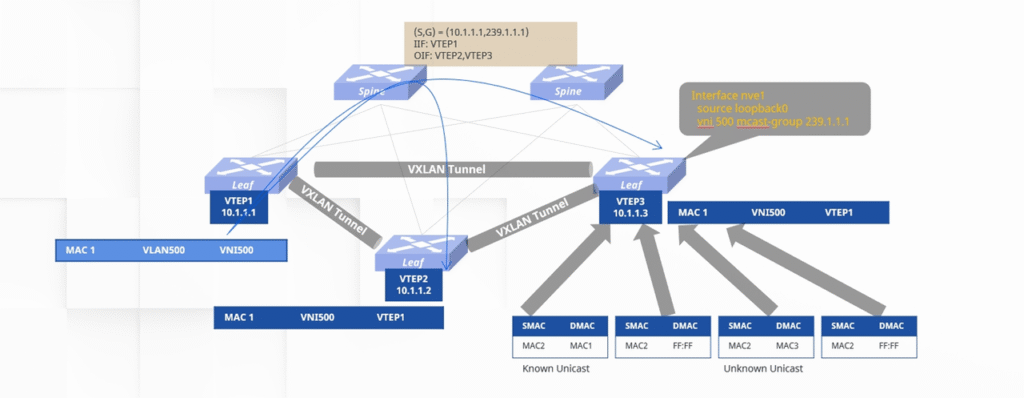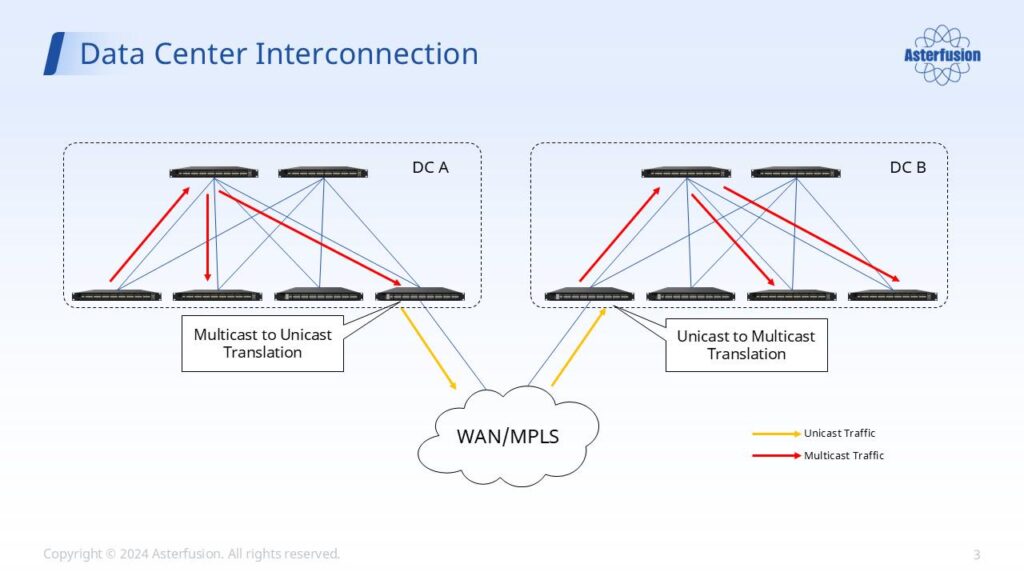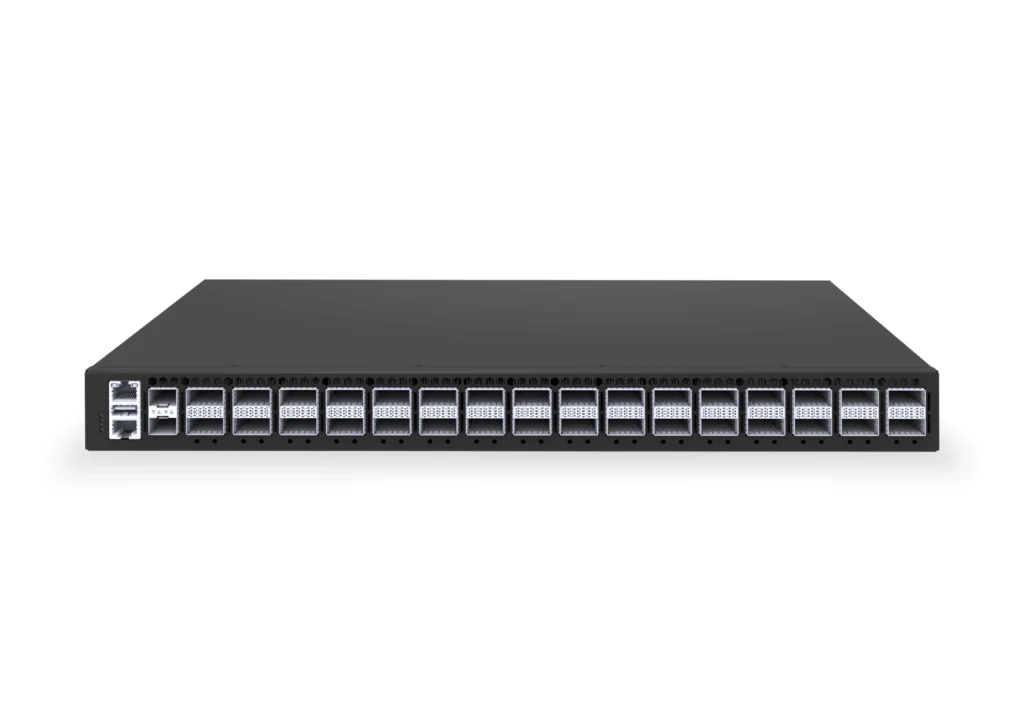Ultra-Low Latency Live Streaming with PTP and VXLAN Multicast in Asterfusion: North America & Japan Case Study Ⅰ
written by Asterfuison
Table of Contents
Project Background
In the mass media industry, latency and time synchronization accuracy have always been issues that need to be considered when building network architectures. In particular, for large media live streaming networks that are distributed across multiple sites and regions, it is very challenging to achieve synchronized distribution of media streams in a media production environment.
We have successfully implemented PTP Class C (<10ns) level clock synchronization based on Asterfusion products in the top 3 live streaming mass media partners in the United States. Combined with Multicast VXLAN EVPN unified Fabric, it provides key support for their live broadcasting and rebroadcasting scenarios.
Meanwhile, this solution has also been successfully applied in the media customer environment in Japan. This article will introduce the core technical architecture and key implementation ideas of the solution, and explain the characteristics of the Asterfusion platform used.
The content focuses on technical principles and solution design, and does not involve specific customer information.
If you are interested or inspired by this case, you can contact us to obtain a more personalized solution for in-depth cooperation.
Ⅰ. PTP for Live Streaming Synchronization
In professional broadcasting systems, time synchronization is a prerequisite for the IP-based media production. Only with an accurate time reference can video frames, audio streams, and ancillary data be aligned at the millisecond or even nanosecond level, thereby ensuring the smoothness and synchronization of program production and playback.
PTP (Precision Time Protocol, IEEE 1588) is the high-precision time synchronization protocol widely recognized in the industry. In the professional media industry, it is manifested as SMPTE 2059, which is a specification of PTP in IEEE 1588 customized for the professional media industry. It is a standard from the Society of Motion Picture and Television Engineers(SMPTE) that describes how to synchronize video equipment over an IP network.
Under the coordination of SMPTE 2059, the ST2110 standards detail how to split video, audio, and data into separate IP streams and route them over the network. These standards are often used together. Below are the purposes of several key standards:
ST2110: SMPTE Standard for Professional Media Over Managed IP Networks
ST 2110-10: System Timing and Definition for ST2110 networks
ST 2110-20: Uncompressed Active Video Transport over IP
ST 2110-21: Traffic Shaping and Delivery Timing for Video
ST 2110-22: Compressed Video Transport over IP using JPEG XS
ST 2110-30: PCM Digital Audio Transport over IP
ST 2110-31: AES3 Transparent Transport over IP
ST 2110-40: Ancillary Data Transport over IP
The Asterfusion Product offers the following advantages in clock synchronization:
- Class C Precision Support (<10ns): The Falcon CX732Q-M-H provides hardware-level PTP timing capabilities with IGMP v2/v3 to implement the ST2110 standard over IP networks. Deployed at the Spine layer, it achieves end-to-end PTP precision of less than 10ns Class C. Configured as a Boundary Clock, it forwards high-precision time signals from the Grandmaster clock to the access layer and end devices.
- Support for Boundary/Transparent Clock Modes: Suitable for multi-level clock distribution in Spine-Leaf Fabrics.
- Standard SAI Interface Support: Ensures compatibility with mainstream broadcast control systems and can be customized as needed.
By aligning PTP with the SMPTE 2059 specification in the media industry, Asterfusion has established a robust time synchronization foundation for the stable transmission of ST2110 media streams.
In addition to the Falcon CX732Q-M-H, which supports Class C precision PTP, the entire range of Asterfusion CX-M switches supports various PTP precision classes and is used at different levels of the customer’s network.
| Product | PTP Time Synchronization ITU Classification | Description |
| CX306P-48Y-M-H | Class C | • 48×25 Gb SFP28, 6×100 Gb QSFP28• Support IEEE1588v2 and SyncE, GNSS receiver, 1PPS, ToD, 10MHz timing interfaces |
| CX102S-8MT-M-S CX102S-8MT-M-SWP CX102S-16GT-M-SWP CX102S-16GT-DPU-M-SWP | Class A | • Support different access rates and enabling flexible deployment across diverse application scenarios• Optional PTP module supports SyncE |
| CX204Y-24GT-M-S CX204Y-24GT-M-SWP2 CX204Y-24GT-M-SWP4 CX206Y-48GT-M-H CX206Y-48GT-M-HWP4 CX206Y-48GT-M-HWP8 CX206P-24S-M-H CX202P-24Y-M-H CX206P-48S-M-H CX308P-48Y-M-H CX532P-M-H CX732Q-M-H CX206Y-48GT-M-H | Class C |
ITU standards G.8273.2/3 define Class A/B/C clocks with Time Errors of ≤50/20/10 ns to meet varying synchronization accuracy needs. How to deploy PTP Network? →For More
Ⅱ. Multicast VXLAN Overlay for Media Delivery
In live broadcasting scenarios, media streams are often high-bandwidth, multi-destination multicast flows, such as ST 2110 video streams. Efficiently transmitting these flows in a multi-tenant, multi-site network is the second core design consideration for live streaming.
The Asterfusion Multicast VXLAN + BGP EVPN solution offers the following core features:
- Multi-tenant Isolation: VXLAN provides multi-tenant isolation capabilities, segmenting different customers or sites using VNI (VXLAN Network Identifier). This allows different ST 2110 media streams to coexist on the same physical infrastructure without logical interference.
- Efficient Multicast Distribution: The solution employs a Multicast Underlay mode, where BUM traffic (Broadcast, Unknown Unicast, Multicast) is encapsulated into VXLAN and mapped to multicast groups in the underlying IP network.

- High-Scalability Multicast Capability:
- Falcon Platform: Supports up to 288K L2/L3 Multicast (shared entries).
- Teralynx Platform: Typically supports 48K Multicast groups in standard configurations.
- Hardware-Level PTP Alignment: Achieves nanosecond-level synchronization between Spine and Leaf in the Overlay clock domain.
Ⅲ. Dual Data Center and Mobile Campus Architecture
The successful deployment of this solution relies not only on the functional features mentioned above but also on its ability to support highly available architectures across regions for live steaming.
1. Primary and Backup Data Centers (Geo-Redundant DCs)
Disaster recovery redundancy between the primary DC and the backup DC is achieved through VXLAN EVPN + MPLS WAN. Media streams can be seamlessly switched between the two locations, ensuring business continuity and production stability.
Here is a simplified topology:

2. Mobile Campus Access (Mobile OB Van)
For mobile OB vans (outside broadcast vehicles) or temporary venue nodes in a campus environment, Asterfusion switches serve as remote VTEPs to connect to the main Fabric.
This ensures synchronization with the core clock domain and access to multicast media streams, whether in the studio or at the field shooting location, significantly reducing the complexity of on-site deployment.
Ⅳ. Commercial Deployment and Results
The solution has been successfully deployed at a major North American broadcasting group and a Japanese media customer, receiving unanimous praise, mainly in the following aspects:
- Current Compatibility: The solution is well-matched with the customers’ existing video processing applications. Multicast traffic is stably distributed across multiple DCs and Campuses, helping customers upgrade their network infrastructure.
- R&D(Research and Development) Capability: Asterfusion’s R&D and customization capabilities have met customer satisfaction regarding specific professional media equipment and other features currently in use. We are also actively promoting further cooperation.
- Future In-depth Collaboration: We are exploring new technological cooperation with customers, including Multicast NAT, to enhance the flexibility and security of media stream transmission across regions and carrier networks.
Ⅴ. Conclusion
Currently, PTP synchronization technology has gradually become a cornerstone for high-quality live streaming, media transmission, and remote production. Asterfusion’s network solution, centered on PTP Class C and combined with Multicast VXLAN + BGP EVPN, meets the requirements of broadcast-level standards such as ST 2110. It also achieves low latency, high synchronization precision, and high reliability across regions, providing a unified network architecture for the live broadcasting industry that integrates high-precision synchronization, low-latency transmission, and large-scale multicast distribution capabilities. Its core technical advantages include:
- Switches support nanosecond-level time synchronization precision (PTP Class C), are compatible with IGMP V2/V3 protocols, and comply with the professional media industry’s ST2059 and ST2110 standards.
- Support for large-scale multicast and NAT forwarding.
- Disaster recovery capabilities across multiple data centers, with flexible access for mobile nodes.
- Standard SAI interface provided, with support for customized expansion.
The successful deployment of Asterfusion’s solution in the US and Japanese markets relies on underlying R&D accumulation and customer-oriented innovation capabilities.
If there is a need to plan a more compatible technical solution for existing network architectures for live streaming, further communication is possible to jointly explore the development direction of the next-generation media transmission network.





